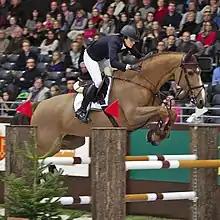Belgian Warmblood
The Belgian Warmblood, Dutch: Belgisch Warmbloedpaard, is a Belgian breed of warmblood sport horse. It is bred for dressage, for show-jumping and for three-day eventing.[1]:164 It is one of three Belgian warmblood breeds or stud-books, the others being the Zangersheide and the Belgian Sport Horse – to which it is closely similar.[2]
 Electra Van't Roosakker ridden by Janika Sprunger, Concours hippique international de Genève, 13 December 2013 | |
| Other names |
|
|---|---|
| Country of origin | Belgium |
| Use | |
| Traits | |
| Distinguishing features | warmblood sport horse |
| Breed standards | |
History
Horse breeders in the Netherlands, Germany, and France had been producing elegant saddle horses for hundreds of years. However, because the Belgian government was concerned about protecting the bloodlines of the Brabant (Belgian draft horse), it was not until the 1950s that breeders in Belgium were allowed to breed lighter saddle horses.[3]
The foundation stock of the Belgian Warmblood included jumping horses from France and the Netherlands, as well as Hanoverians and Holsteiners from Germany.
The first stallion show for riding horses in Belgium took place, illegally, in 1953; the BWP was founded in 1955. Without native riding horses or all-purpose heavy warmbloods, Belgian breeders had to import stallions and mares. Over the course of 50 years, the BWP accrued a mare base of over 3,500 broodmares and produced a significant number of international-quality show jumpers. In 2010, the BWP was ranked 4th in the FEI/WBFSH International Show Jumping standings, below only the KWPN-Dutch Warmblood, Selle Français and Holsteiner studbooks.[4]
Breed characteristics
As a warmblood horse, the Belgian Warmblood is characterized not by uniformity of coat color, appearance or pedigree chart, but by uniformity of purpose. Like other warmbloods, Belgian Warmblood breeding horses are subjected to rigorous studbook selection.

The most reliable way to positively identify a Belgian Warmblood is by the brand on the left thigh. Belgian Warmblood foals receive this brand during their foal inspection, when they are given a passport and deemed free of obvious defects.
Between the ages of three and four years old, Belgian Warmblood stallions are presented to a jury in a "Hengstenkeuring" or stallion licensing test. The licensing test consists of a veterinary inspection, subjective evaluation of the stallion's conformation and jumping ability without a rider, and evaluation of the stallion's qualities under saddle. Stallions that do not achieve the desired marks in the licensing test are not eligible for the studbook. To retain status in the studbook, stallions must participate in competitions for young show jumping horses called the "Classic Cycle".[5] Mares take part in similar conformational evaluations, however judgement of a mare's qualities as a riding horse are elective.
Belgian Warmbloods range in size and substance, but the ideal size for a stallion is between 16 and 17 hands high at the withers. Mares are not eligible for breeding rights unless they exceed 15.1 hands high.[6] In type, the Belgian Warmblood is similar to the Holsteiner, Selle Français, Dutch Warmblood, and Hanoverian, and less like the Trakehner.
Use
_CSIO5*_2008.jpg.webp)
Over the past 20 years, research has supported observations regarding the high heritability of jumping ability compared with that of dressage-quality gaits.[7]
References
| Wikimedia Commons has media related to Belgian Warmblood. |
- Élise Rousseau, Yann Le Bris, Teresa Lavender Fagan (2017). Horses of the World. Princeton: Princeton University Press. ISBN 9780691167206.
- Miller, Laura (February 2006). "L'Equipage Farm" (PDF). Equine Journal (Zone II): 12. Archived from the original (PDF) on 2011-07-10. Retrieved 2009-05-15.
- Chris Hector. "Belgian Warmbloods". The Horse Magazine. Archived from the original on 2003-12-08. Retrieved 2007-11-01.
'As late as the 50s in Belgium we had the heavy horses – the Brabants – and to protect the breeding of the heavy horses, it was not allowed to breed anything else.'
- "FEI/WBFSH World Ranking List – Jumping Horses by Studbook 2010" (PDF). WBFSH. Retrieved 2011-02-13.
- "Belgisch Warmbloedpaard (BWP)" (PDF). Katholieke Universiteit Leuven. Retrieved 2011-02-13.
- BWP-NAD. "Belgian Warmblood Book 2007" (PDF). Archived from the original (PDF) on 2011-07-07. Retrieved 2007-11-01.
- Christmann, Dr. Ludwig (2003). "Specialists or All-rounders? Degrees of heritability and genetic correlations in the Hanoverian breed". Archived from the original on 8 October 2007. Retrieved 2007-11-01.